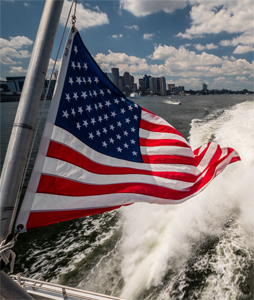Think Boston, think tradition. The naming of two new fast ferries, Champion and Glory, for the Massachusetts Bay Transportation Authority (MBTA) complies with the city’s maritime history.
Delivered in October 2017, Champion honors the legacy of master shipbuilder Donald McKay’s Champion of the Seas, a clipper that set a record in 1854 for the fastest day’s run — 465 miles in 24 hours — during its maiden voyage from England to Australia. Delivered in May 2018, sister ferry Glory is named for McKay’s Glory of the Seas clipper. The two other fast ferries in the MBTA fleet, Flying Cloud and Lightning, are also named for McKay clippers.
Also consistent among the four vessels is the builder, Gladding-Hearn Shipbuilding of Somerset, Mass., and the designer, Incat Crowther of Australia. The shipyard was selected in a competitive bid process.
“We were pleased to partner with Gladding-Hearn on this project and provide our customers with state-of-the-art, locally built (vessels),” said MBTA General Manager Luis Manuel Ramirez.
 |
|
“This is like getting into a brand-new car,” says Capt. Tom Cristoferi, shown at the helm of Champion. “It has all the bells and whistles you could ask for.” |
MBTA’s public boat service provides water transportation via contract operator Boston Harbor Cruises. The commuter ferries connect Hull, Hingham, Georges Island (seasonal), Logan Airport in East Boston and Long Wharf in Boston.
Champion and Glory are bow-loading, high-speed aluminum catamarans with a 150-passenger capacity. The Boston Harbor docks are matched to their bows for quick passenger loading and unloading. In addition to improving reliability, the new vessels allow MBTA to have a spare ferry that covers for others in the fleet during maintenance and U.S. Coast Guard inspections.
On Champion’s bridge at the Hingham terminal, Capt. Tom Cristoferi took up his position at the port-side window, manning a HamiltonJet remote propulsion and steering control. After deck hands Denis Kinneen and Scott Underdown let go of the lines, Cristoferi backed Champion out of the slip, turned to port, returned to the fixed vessel controls on the console, and headed out of Hewitt’s Cove for Georges Island, Logan Airport and Long Wharf.
The vessels are powered by twin Caterpillar mains shafted to ZF Marine gears and HamiltonJet waterjets. The powertrains deliver a total of 2,900 hp at 2,100 rpm and a top vessel speed of 29 knots.
 |
|
Deck hand Scott Underdown checks on one of Champion’s Caterpillar C32 Tier 3 mains. |
Amenities include flat-screen passenger information systems, energy-efficient LED lighting, tables and seating to accommodate 110 passengers, carpeted interior decks, a concession stand and luggage racks. The new ferries also have wide aisles, wheelchair access, handicapped-accessible heads, mobility device stations and audio induction loops for the hearing impaired.
“I like all of it,” Cristoferi said. “This is like getting into a brand-new car. It has all the bells and whistles you could ask for. And the layout for the passengers and crew is top of the line. It meets all the ADA (Americans with Disabilities Act) requirements, and is very easy to load from the bow ramp.”
Ramirez said Champion and Glory were smart investments in Greater Boston water transportation. The cost of each new vessel was approximately $5.7 million.
“We have the most reliable MBTA equipment as far as on-time schedules and continuous operation,” Cristoferi said. “When the harbor freezes over, we follow the icebreakers from our offshore division and keep running.”
 |
 |
|
|
Deck hands Denis Kinneen, left, and Scott Underdown raise the ramp after passengers disembark Champion at Georges Island. |
Open decks on Champion and Glory allow passengers to soak up the sun as they take in the sights of Boston Harbor and nearby islands. |
|
Champion and Glory specifications |
| Owner/operator: Massachusetts Bay Transportation Authority, Boston, Mass. Designer/builder: Incat Crowther, Belrose, Australia/Gladding-Hearn Shipbuilding, Somerset, Mass. Dimensions: L: 90’ B: 28.8’ D: 4.2’ Mission: Commuter ferries Crew size: (3) one master and two deck hands |
|
PROPULSION CAPACITIES NAVIGATION/COMMUNICATIONS ADDITIONAL EQUIPMENT CLASSIFICATIONS |

